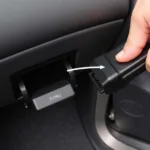A car diagnostic tool, often equipped with function keys, can seem intimidating at first. However, understanding how to use these function keys unlocks a wealth of information about your vehicle’s health. This guide will demystify using function keys on your car diagnostic tool, equipping you to diagnose and potentially fix car problems efficiently.
Understanding Function Keys
Function keys, those labeled F1 through F12 on your diagnostic tool, are your shortcuts to various diagnostic functions. These keys offer a faster way to navigate your tool’s menus and execute commands, compared to scrolling through multiple screens.
Common Function Key Uses
Function keys offer a standardized approach to car diagnostics, though their exact function may vary slightly based on the make and model of your tool. Here are some typical functions associated with these keys:
- F1 (Help): Provides context-sensitive help for the current screen or function.
- F2 (Codes): Accesses the vehicle’s stored Diagnostic Trouble Codes (DTCs).
- F3 (Data): Displays live data streams from various sensors in your car.
- F4 (Erase): Clears DTCs from the vehicle’s memory after repairs.
- F5 (Graph): Presents data parameters in a graphical format for easier analysis.
- F6 (Record/Playback): Allows you to record live data for later review or playback previous recordings.
- F7 (Special Functions): Offers access to advanced diagnostic functions, such as component activation, adaptations, and programming.
Navigating with Function Keys
 Function Keys on Diagnostic Tool
Function Keys on Diagnostic Tool
Besides their primary roles, function keys also aid in navigating your diagnostic tool’s interface:
- Arrow Keys: Used for moving between menu options and selecting items.
- Enter Key: Confirms selections and executes commands.
- Esc Key: Allows you to return to the previous menu or cancel an action.
Maximizing Your Diagnostic Tool
To maximize your diagnostic tool’s potential, familiarize yourself with its user manual. This will outline the specific functions assigned to each key on your particular model.
Here are some additional tips for effective usage:
- Understand Your Tool: Invest time in learning the layout, menus, and capabilities of your specific diagnostic tool.
- Consult the Manual: Keep your tool’s user manual handy. It’s your best resource for understanding specific functions and troubleshooting.
- Practice Makes Perfect: Regularly use your diagnostic tool, even for simple tasks. This familiarity will prove invaluable when dealing with complex issues.
Beyond the Basics: Advanced Function Key Applications
As you become more comfortable, explore the advanced functionalities often accessible via function keys. These can include:
- Component Activation: Function keys can be used to activate specific components like fuel injectors or solenoids, aiding in isolating faulty parts.
- Adaptations: Some vehicles require resetting adaptations after repairs. Function keys can facilitate this process, ensuring optimal performance.
- Programming and Coding: Certain diagnostic tools allow for programming and coding of vehicle modules using function keys. However, this requires a deep understanding and should be approached cautiously.
Conclusion
Mastering the use of function keys on your car diagnostic tool significantly enhances your diagnostic capabilities. By understanding their core functions and exploring advanced applications, you’re well on your way to becoming a confident DIY mechanic. Remember, regular practice and consultation with your tool’s user manual are key to unlocking its full potential.
For those seeking to delve deeper into specific car diagnostic techniques, DiagFixPro offers a wealth of resources. Learn about using an oscilloscope for car diagnostics or explore our car engine diagnostic app for comprehensive troubleshooting.
Don’t hesitate to connect with us for tailored support and expert advice on all your car diagnostic needs. Contact us via WhatsApp at +1(641)206-8880 or email us at [email protected]. Our team is available 24/7 to assist you.

